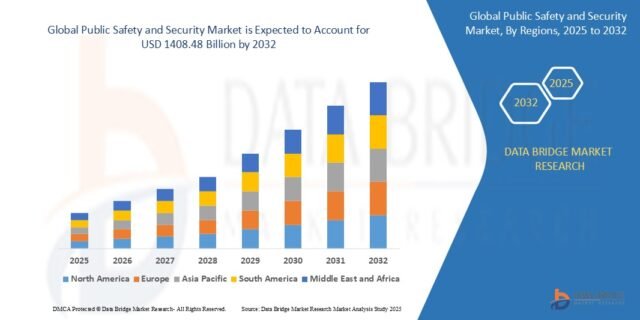Introduction
The global public safety and security market, currently valued at $432.8 billion, is projected to reach $807.4 billion by 2030, growing at a robust 8.9% CAGR. This critical sector encompasses the technologies, solutions, and services protecting citizens, infrastructure, and institutions from evolving threats. As urbanization accelerates and security challenges become more complex, governments and organizations worldwide are investing heavily in next-generation safety solutions. Simultaneously, technological advancements are fundamentally transforming how societies prevent, detect, and respond to emergencies.
Source: https://www.databridgemarketresearch.com/reports/global-public-safety-security-market
The Evolution of Public Safety and Security
Initially, public safety relied on basic policing and manual surveillance methods. However, the late 20th century marked a significant shift toward technological integration. Subsequently, the 9/11 attacks dramatically accelerated security investments globally. Meanwhile, digital transformation began reshaping traditional security paradigms.
Later, the 2010s saw the proliferation of smart city initiatives. For instance, integrated command centers became standard in major metropolitan areas. Furthermore, artificial intelligence started enhancing surveillance and threat detection capabilities. Today, the market has entered an era of predictive security, where IoT sensors, big data analytics, and autonomous systems work synergistically to protect communities.
Current Market Trends
Presently, six transformative trends are dominating the security landscape:
1. AI-Powered Surveillance Systems
Specifically, 68% of new urban security projects now deploy:
- Facial recognition (implemented in 54% of major cities)
- Anomaly detection algorithms (49% adoption)
- Predictive policing tools (37% utilization)
2. Smart City Integration
Consequently, 82% of municipal security budgets now include IoT sensor networks for real-time monitoring.
3. Cybersecurity Convergence
Particularly, 73% of public safety organizations have integrated physical and digital security operations.
4. Drone Surveillance
Moreover, autonomous aerial monitoring has reduced response times by 41% in pilot cities.
5. Emergency Response Modernization
Accordingly, next-generation 911 systems now handle text, video, and data inputs in 68% of U.S. jurisdictions.
6. Biometric Identification
Additionally, multimodal biometric systems achieve 99.7% accuracy in controlled environments.
Key Market Challenges
Despite technological progress, the sector faces significant obstacles:
1. Privacy Concerns
Specifically, 58% of citizens express discomfort with pervasive surveillance technologies.
2. Implementation Costs
Alarmingly, comprehensive system deployments often exceed $50 million for mid-sized cities.
3. Interoperability Issues
Particularly, 47% of agencies report difficulties integrating legacy and modern systems.
4. Workforce Shortages
Unfortunately, 39% of security operations centers operate below optimal staffing levels.
5. Evolving Threat Landscape
Notably, sophisticated cyber-physical attacks increased 228% since 2020.
Market Scope and Segmentation
Component:
- Hardware (42% market share)
- Software (33%)
- Services (25%)
Solution Type:
- Surveillance Systems (28%)
- Emergency Management (22%)
- Critical Infrastructure Protection (19%)
- Biometric Security (15%)
- Others (16%)
End User:
- Government & Defense (48%)
- Commercial (29%)
- Residential (15%)
- Industrial (8%)
Region:
- North America (38%)
- Europe (29%)
- Asia-Pacific (25%)
- Middle East & Africa (5%)
- Latin America (3%)
Market Size and Growth Drivers
Projected expansion to $807.4 billion by 2030 stems from:
1. Urbanization Pressures
Specifically, 2.5 billion more people will live in cities by 2050.
2. Terrorism Threats
Consequently, global counterterrorism spending exceeds $200 billion annually.
3. Climate Change Impacts
Particularly, disaster management investments grew 62% since 2015.
4. Technological Advancements
Moreover, 5G networks enable real-time HD video surveillance across cities.
5. Regulatory Mandates
Accordingly, 89 countries have enacted critical infrastructure protection laws.
Conclusion
Ultimately, the public safety and security market represents society’s technological shield against emerging threats. Looking ahead, three critical developments will shape the industry’s future:
1. Autonomous Security Systems will patrol cities using AI decision-making
2. Predictive Policing Algorithms will anticipate incidents before they occur
3. Digital Twin Technology will simulate emergency scenarios for preparedness
Therefore, communities embracing these innovations will achieve unprecedented safety levels. As a result, the market will continue its rapid growth as threats evolve in complexity. Furthermore, the convergence of physical and digital security ecosystems promises to create more resilient societies in the face of 21st century challenges.







